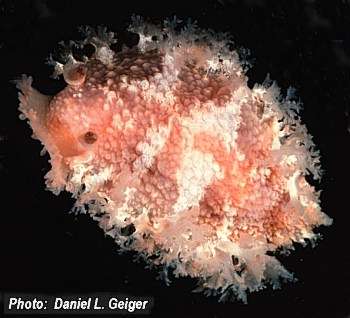
Tritonia hombergii
Cuvier, 1803
Order: NUDIBRANCHIA
Suborder: DENDRONOTINA
Family: Tritoniidae
DISTRIBUTION
Northeastern Europe from Norway to Mediterranean coast of Spain.
PHOTO
UPPER RIGHT: United Kingdom, Scotland, Isle of Cumbrae, Millport, intertidal, May 1993.
LOWER PHOTOS: Left - egg mass, Right - subadult. United Kingdom, Scotland, Outer Hebrides, St. Kilda, Boreray, 23m, vertical wall, 1993. PHOTOS: Daniel Geiger.
This large nudibranch grows to over 200mm in length. The body colour changes as the animal ages from white to the mottled colour in the photos. Juveniles were originally considered a different species Tritonia alba and because the radular morphology changes from juveniles to adults, the discovery they were the same species was relatively recent. Many aspects of its anatomy and biology were studied extensively by the late Tom Thompson. It feeds in the softcoral Alcyonium digitatum and despite its large size, has an annual life cycle.
Note added 17 May 2007: The spelling of the name on the Forum as T. hombergi has been corrected to T. hombergii. See message #19914.
-
Thompson, T.E. & Brown, G.H. (1984) Biology of Opisthobranch Molluscs, Vol 2. Ray Society: London.
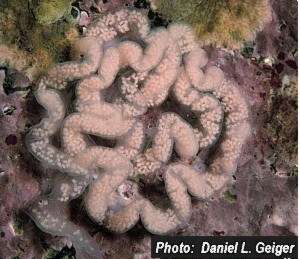
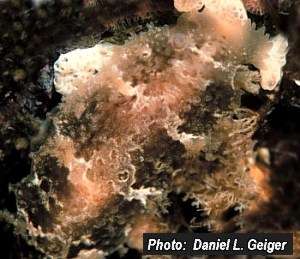
Rudman, W.B., 1999 (September 16) Tritonia hombergii Cuvier, 1803. [In] Sea Slug Forum. Australian Museum, Sydney. Available from http://www.seaslugforum.net/find/trithomb
Related messages
Tritonia hombergi or T. hombergii
May 17, 2007
From: Jim Anderson
Dear Bill,
I have just updated my Scottish Nudibranchs website and in checking my links to ensure they work as I expect I came across an anomaly.
You (and I) have the spelling of Tritonia hombergi with one 'i', Bernard Picton (and others) have 2. Which spelling is correct, if there is a 'correct'?
I doubt nations will split or engage in hostilities over this but for those of us without a classical education it would be interesting to know which it should be. Thanks again for all your wonderful work with the Forum, one of my daily reads.
Kindest regards,
Jim A
jander4454@gmail.com
Anderson, J., 2007 (May 17) Tritonia hombergi or T. hombergii. [Message in] Sea Slug Forum. Australian Museum, Sydney. Available from http://www.seaslugforum.net/find/19914Dear Jim,
I have just checked Cuvier and find that he spelt it T. hombergii. Unfortunately I followed Tom Thompson's various publications and Russell's Index Nudibranchia and spelt it with a single i. The spelling i or ii is not a question of grammar but preference. The International Rules recommend a single i but of course we can't change original spellings which use ii. I have had a look at Cuvier's description and he spells it with a double ii.
I then checked the ICZN Official Lists and Indexes of Names and Works in Zoology (1987) and found this entry:
hombergii, Tritonia, Cuvier, 1803, Ann. Mus. Hist. nat., Paris
1 : 483 (specific name of type species of Tritonia Cuvier,
[1797] (Gastropoda) 0. 668
So I guess I had better make the necessary changes on the Forum
Thanks for drawing my attention to this
Best wishes,
Bill Rudman
Re: Pigmentation in Tritonia
April 16, 2005
From: Sylvie Grall
Dear Eleonor,
A small contribution to your question [#13414]: in the Mediterranean, we find Tritonia nilsodheri (very white) usually on white gorgonians (Eunicella singularis) but also (more creamy with gray lines) on orange/white polyps Lophogorgia ceratophyta.
A remark about Elysia viridis pigmentation: on the same dive last week-end (April 2nd) in the étang de Thau (Med/France) I found green ones but also creamy white coloured individuals, brown ones and even an almost black one! All seemed in perfect health.
Good study!
Sylvie Grall
sgrall@compuserve.com
Grall, S., 2005 (Apr 16) Re: Pigmentation in Tritonia. [Message in] Sea Slug Forum. Australian Museum, Sydney. Available from http://www.seaslugforum.net/find/13499Re: Pigmentation in Tritonia hombergi
April 14, 2005
From: Jim Anderson
Hello Eleanor,
I read your appeal for information [#13414]. From my observations diving up here in Scotland T. hombergi has been found in colonies of A. digitatum of mixed colour ranging from white through to orange. I have not noticed any particular co-relation between colour of animal and the colour of the digitatum they are eating and also wonder how the Tritonia would identify the colour of its food.
I will keep a look out for colour co-relations and report back if that
is of any help.
Kind regards,
Jim Anderson
http://www.scottishnudibranchs.co.uk
jander4454@gmail.com
Anderson, J., 2005 (Apr 14) Re: Pigmentation in Tritonia hombergi. [Message in] Sea Slug Forum. Australian Museum, Sydney. Available from http://www.seaslugforum.net/find/13422Pigmentation in Tritonia
March 25, 2005
From: Eleanor Vesty
I am currently studying Marine Biology at the University of Plymouth, England. I am hoping to conduct my 3rd year dissertation on the identification and origin of pigments in Tritonia hombergi. I understand that it often matches the colour of the soft coral it feeds upon. I am interested in finding out whether its colouration comes from pigments assimilated from Alcyonium digitatum or whether it produces them itself. I will be using chromatography methods to separate out and identify the different pigments and compare them against standards. I also hope to possibly trace the pigments back to the phytoplankton that the corals feed on.
I have also been advised that Tritonia nilsodhneri shows similar actions and often closely matches the colour of the gorgonian it feeds upon. I have read many of the articles on this site and would just like to appeal for any information anyone could give me. In particular if anyone knows which of the above two would be a better, more abundant species to study in this area (Plymouth)? Possible pigments that could cause orange, yellow or pink colouration? Whether Tritonia nilsdhneri feeds on different gorgonians or just one species? Any information would be greatly received.
Please email any relevant information to me
Many thanks
Eleanor Vesty
ellyvesty@hotmail.co.uk
Vesty, E., 2005 (Mar 25) Pigmentation in Tritonia. [Message in] Sea Slug Forum. Australian Museum, Sydney. Available from http://www.seaslugforum.net/find/13414Dear Elly,
Your project sounds very interesting. Please keep us informed of your progress. Elly asks for anyone with information or ideas to email her directly. Could anyone who does so, please send a copy to the Forum as well. This background information is of interest to many of us and posting it publicly, can generate further comments and ideas
Best wishes,
Bill Rudman
Re: Food & colour in Tritonia hombergi
May 3, 2001
From: Bernard Picton
Hi Bill,
Regarding small juvenile Tritonia hombergi, I have seen these on Alcyonium digitatum and as Jane says, they are well-camouflaged by their matching colour. However they must suffer high predation as juveniles can be very numerous but result in very few full-grown individuals at the same site. I wonder if in fact there is a balanced polymorphism with high fish predation controlling the colour of surviving individuals in shallow water - Alcyonium is usually in strong tidal streams or wave action and can also be in deep turbid water where fish would not see the Tritonia well. Tritonia hombergi adults seem to be more common in dredge hauls from deeper water and seem to be partly nocturnal or in crevices by daytime in shallow water. I suspect that we are not seeing the main breeding populations by diving.
Oddly Alcyonium on the west coast of Ireland is nearly all orange/yellow in colour whilst in SW England it is almost all white. In Scotland both colours occur.
Bernard Picton
bernard.picton.um@nics.gov.uk
Picton, B., 2001 (May 3) Re: Food & colour in Tritonia hombergi. [Message in] Sea Slug Forum. Australian Museum, Sydney. Available from http://www.seaslugforum.net/find/4272Thanks Bernard,
Bill Rudman
Food & colour in Tritonia hombergi
April 29, 2001
From: Jane Lilley
Dear Bill,
I have just read the past contributions on Tritonia hombergi with interest. I saw quite large numbers of juveniles and one larger individual in the Outer Hebrides of western Scotland, U.K., last autumn. Usually there seemed to be a clear link between the colour of individuals and their diet, but not invariably. I'd appreciate other people's views on what was going on - I'm just guessing!
Very small juveniles, 3 - 8 mm long, were numerous once I 'got my eye in'. They appeared as low bumps on the lobes of the soft coral Alcyonium digitatum, between the polyps; the larger ones showed enough detail to confirm the I.D. They were present on both yellow and white colonies of A. digitatum, and usually matched their host's colour exactly: pure white on white colonies, and the identical shade of yellow on yellow colonies. I assume they were utilising pigment from their food.
But at two sites, I found tiny yellow T. hombergi both on yellow A. digitatum and the adjacent white colonies. In view of the usual perfect colour-match, I guessed that they had recently moved from one host to another. Elsewhere, I saw as 8 mm specimen on a yellow soft coral which had a yellow body but white gills - had it recently moved host and was now gradually changing colour, or was something else going on? (I have seen the same thing in Tritonia nilsodhneri at sites where the host sea fan, Eunicella verrucosa, was present in both pink and white forms.)
I rarely see larger Tritonia hombergi. They are reported to move off the soft corals onto the adjacent substratum, and to become darker and more varied in colour, presumably to be cryptic against the general background. Apparently they live for two years and can grow to 8 inches (20 cm) long, but they are very unobtrusive.
However, I saw a 4 inch long specimen in the Hebrides which was a uniform bright yellow - from a distance I thought it was a sponge. So they don't all change colour. It was feeding actively on a small yellow colony of Alcyonium digitatum, and descriptions state or imply that large individuals still feed exclusively on this species. But is this invariably the case, or is it possible that most of them change colour because they have adopted a more varied diet? (Tritonia nilsodhneri seem to change colour to some extent when they are off their usual prey - I can give details if anyone is interested.)
Can anyone make any useful comments?
Jane Lilley
PDL@mm-brig.mottmac.com
Lilley, J., 2001 (Apr 29) Food & colour in Tritonia hombergi. [Message in] Sea Slug Forum. Australian Museum, Sydney. Available from http://www.seaslugforum.net/find/4251Thanks Jane,
If you have any photos of these colour forms and their food they would be very interesting. I guess you are aware that for many years juvenile T. hombergi were thought to be a distinct species, Tritonia alba, based on both differences in external shape and colour and in the shape of the radular teeth. So any observations like yours are always of interest as they may give someone a clue to some puzzle they have been trying to solve for years. For the same reasons, your observations on T. nilsodhneri would be welcome.
best wishes,
Bill Rudman
Tritonia hombergi from Scotland
October 3, 2000
From: Peter H. van Bragt
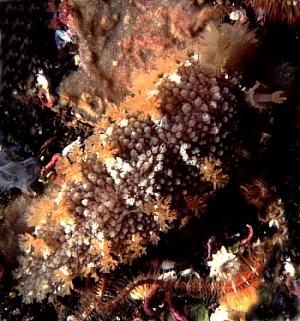
Hallo Bill
Enclosed you will find several images of juveniles, adults (with details of their most pretty rhinophores) and spawn of Tritonia hombergi. All photographs were made in Lough Carron, Scotland in the summers of 1996 and 1997. T. hombergi typically feeds on the soft coral Alcyonium digitatum, which is rather rare on the dutch coast. So, obviously this nudi is
also a very rare find at our coast. T. hombergi is on our fauna list as in 1950 a few juvenile specimen were washed ashore on some pieces of wood, and sometimes they are found in the nets of fishermen out on the North Sea on pieces of Alcyonium digitatum.
We'll keep you informed if more specimen are found.
Best regards
Peter H. van Bragt
vanbragt.phjm@hsbrabant.nl

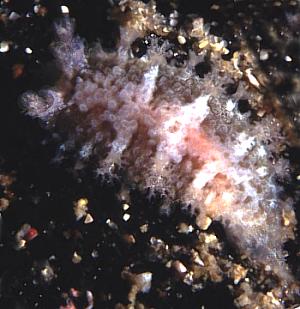
Thanks Peter,
I have put your photos of the head and rhinophores on a separate page.
I would be grateful for some information on the size of different specimens. Is colour related to size?
Best wishes,
Bill Rudman.
Tritonia hombergi - head and rhinophores
October 3, 2000
From: Peter H. van Bragt
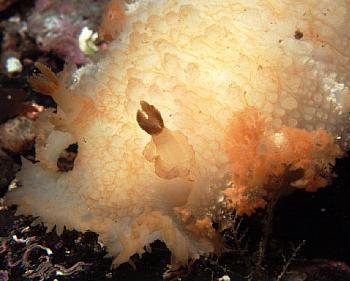
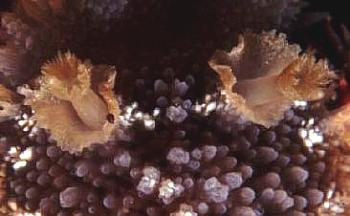
Hallo Bill
To accompany my earlier message, here are two photos showing details of the head and rhinophores of Tritonia hombergi. All photographs were taken at in Lough Carron, Scotland in the summers of 1996 and 1997.
Best regards
Peter H. van Bragt
vanbragt.phjm@hsbrabant.nl
van Bragt, P.H., 2000 (Oct 3) Tritonia hombergi - head and rhinophores. [Message in] Sea Slug Forum. Australian Museum, Sydney. Available from http://www.seaslugforum.net/find/3044Thanks Peter,
It woud be interesting to know if the pale animal in your upper photo is a juvenile. I understand very small juveniles of this species are white. Is colour and size related in larger animals?
Best wishes,
Bill Rudman.
Re: Tritonia lineata? from Malta
September 18, 1999
From: Constantine Mifsud
Thank you Bill and Bernard.
Indeed the specimen was rather small and bruised. However there were traces of interrupted opaque white dorsal side lines and a rather longish "tail". Would small juveniles of T. hombergi be so different from the adult?.
The other species recorded from here are;
Tritonia manicata Deshayes, 1853 &
Tritonia cf. striata. Haefelfinger, 1963 both by SAMMUT & PERRONE 1998:230
Constantine
kejdon@orbit.net.mt
Mifsud, C., 1999 (Sep 18) Re: Tritonia lineata? from Malta. [Message in] Sea Slug Forum. Australian Museum, Sydney. Available from http://www.seaslugforum.net/find/1352Dear Constantine,
Perhaps the white markings you mention may be distinctive enough for Bernard to comment, but perhaps you should consider having a look at the radula. Thompson & Brown illustrate a number of Tritonia radulae, and with the very distinctive radula of juvenile T. hombergi it should be possible to get a few more clues.
Bill Rudman.
Re: Tritonia lineata? from Malta
September 17, 1999
From: Bernard Picton
I've just looked at Constantine's pictures from Malta, and my feeling is that it is more likely to be a juvenile Tritonia hombergi. These are often almost translucent with some white pigment. The body looks too broad for T. lineata. See my page at: http://www.pictonb.freeserve.co.uk/nudibranchs/trilin.html
Bernard Picton
bernard.picton.um@nics.gov.uk
Picton, B., 1999 (Sep 17) Re: Tritonia lineata? from Malta. [Message in] Sea Slug Forum. Australian Museum, Sydney. Available from http://www.seaslugforum.net/find/1343Dear Bernard,
Thanks for clearing up this, and the identities of the two unidentified aeolids from Scotland.
Bill Rudman.
Tritonia hombergi
September 17, 1999
From: Bill Rudman
Thanks to some great photos by Daniel Geiger, I have prepared a page on Tritonia hombergi to accompany Bernard Picton's message on the Tritonia from Malta.
Bill Rudman.
Tritonia lineata? from Malta
September 9, 1999
From: Constantine Mifsud
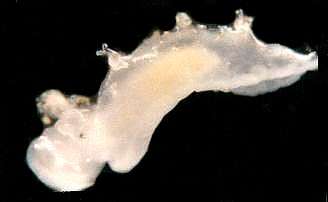
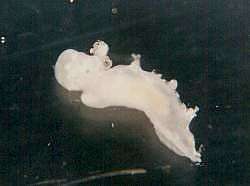
Dear Bill,
I am posting a couple of photos of a Tritonia species which I have just found. It was found in dredgings from a hard substrate at a depth of 70-80m. from off Blata Steps, Malta.
The specimen was found in a rather bad condition, but my conclusions are that it is a juvenile Tritonia lineata Alder & Hancock, 1848. The 3mm specimen is completely translucent white with opaque white linear lines on its sides. The cerata do seem to belong to this species. Any opinions please?
Constantine Mifsud
kejdon@orbit.net.mt
Mifsud, C., 1999 (Sep 9) Tritonia lineata? from Malta. [Message in] Sea Slug Forum. Australian Museum, Sydney. Available from http://www.seaslugforum.net/find/1315Dear Constantine,
It looks as though its foregut has burst out through the mouth. I am not sure what you mean by white lines on its sides. Do you mean the edge of the notum or do you mean on the sides of the body below the gills. I understand adult Tritonia lineata have a white line down each side of the dorsum
connecting to the inside base of each of 6 gills on each side.
But let's see if anyone can help. I am not familiar with the species.
Bill Rudman.
